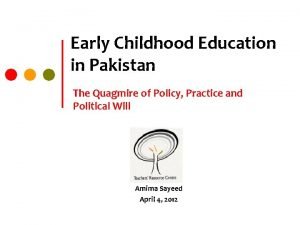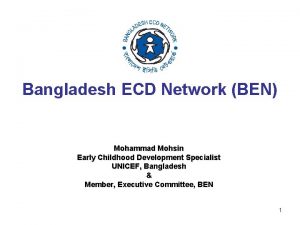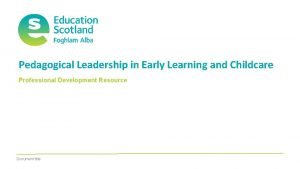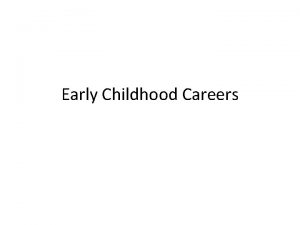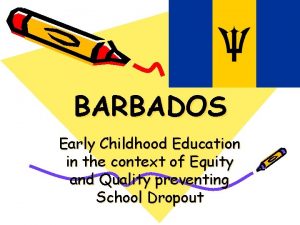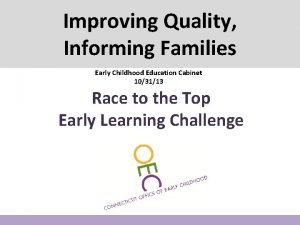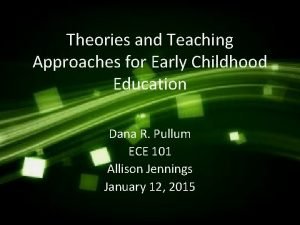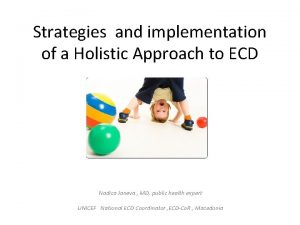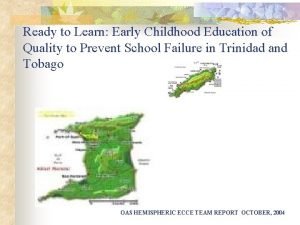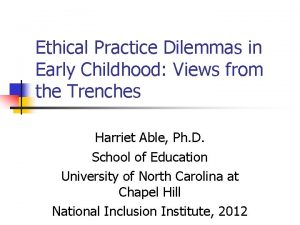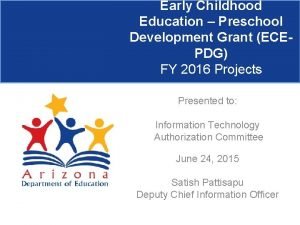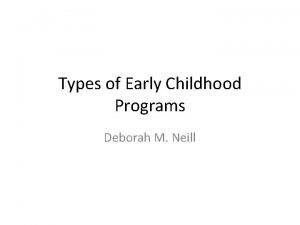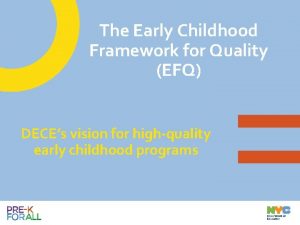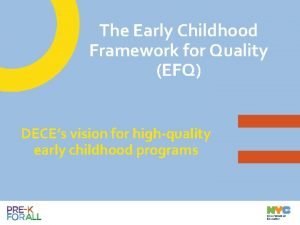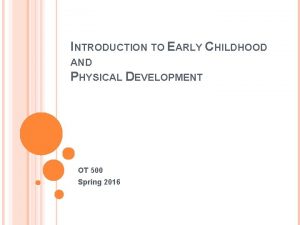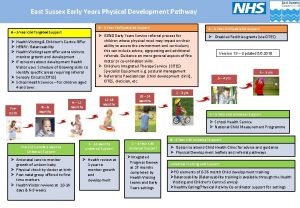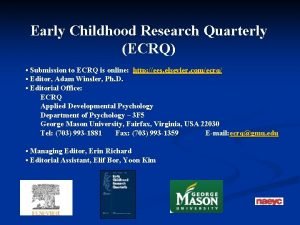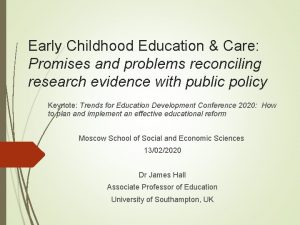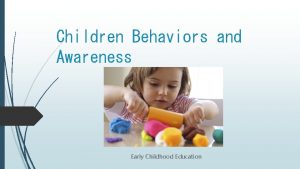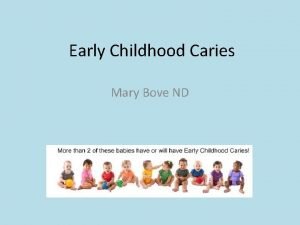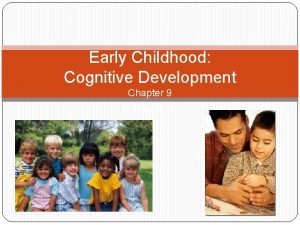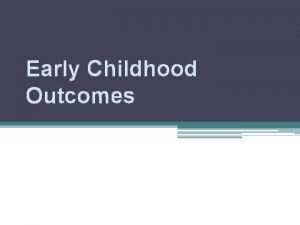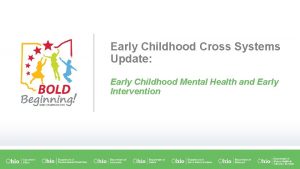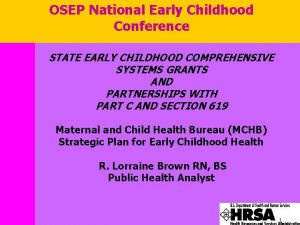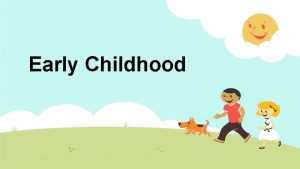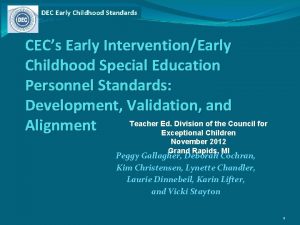Early childhood education and highrisk children Promises and


























- Slides: 26

Early childhood education and high-risk children Promises and Pitfalls Brenda Jones Harden, Ph. D University of Maryland OMEP Conference August 1, 2015

Poverty and Child Development ► Major risk factor for maladaptive outcomes ► Larger associations with cognition and academic achievement than behavior, mental health, and physical health ► Largest impacts of poverty for children at lower end of low-SES continuum ► Poverty in early childhood matters more for development than poverty in adolescence ____________________ Aber et al. , 2007; Duncan & Brooks-Gunn, 1997; Mc. Loyd, 1998

Physical Effects of Poverty ► Stunted brain growth and CNS disorders ► Delayed physical growth ► Delayed motor skills ► Higher rates of infant mortality, prematurity, low birthweight ► Higher rates of injuries ► Increased morbidity (e. g. , asthma, HIV seropositivity, obesity, dental decay) ______________________ Aber et al. , 2007; Barker et al. , 2005; Frongillo, 2003; Crum et al. , 2005; Iida et al. , 2007

Cognitive Effects of Poverty ► Compromised development brain § Cognitive selfregulation ► Lower DQ’s and IQ’s ► Language delays ► School readiness ► Later academic difficulties Aiken & Barbarin, 2008; Duncan & Brooks

Socioemotional Effects of Poverty ► Compromised prosocial skills § Empathy, cooperation ► Affective dysregulation § Aggression, emotional lability ► Higher rates of mental health difficulties § Internalizing/externalizing behavior problems ► Later difficulties with peers __________________ Conroy & Brown, 2004; Webster-Stratton et al. , 1998; Campbell 1994; 2002

What are the mechanisms by which poverty affects children? To what extent is poverty itself the cause of negative child outcomes?

Attention to Omitted Variables (Duncan et al. , 2010) ► Demographic variables § Family structure § Race/ethnicity ► Prenatal factors § Prematurity/low birthweight ► Larger ecological factors § Neighborhood disadvantage ► Poverty-related risk factors

Risk Factors Linked to Poverty ► Low socioeconomic status linked with multiple contextual risks which increase child vulnerability (Chase-Lansdale & Brooks-Gunn, 1995) § § § Inadequate nutrition / food insecurity Environmental toxins Parental psychopathology Parental substance abuse Compromised parenting & child maltreatment Lower quality child care and schools ►Higher quality child care in some studies due to availability of government-sponsored child care

Developmental Consequences of Pre/Post-Natal Substance Exposure § Prematurity/low birthweight § Neonatal Abstinence Syndrome (opiates) § Respiratory difficulties (tobacco, methamphetamine) § Intellectual disabilities (alcohol) § Language delays § Neurobehavioral deficits § Affective dysregulation § Attentional deficits and hyperactivity § Impulsivity and aggression § Internalizing behaviors ________________________ Lester et al. , 2009; Frank et al. , 2001

Developmental Consequences of Maternal Depression ► Prenatal effects ► Differential emotion processing § Frontal EEG asymmetry ► Neurointegrative deficits § Distractibility; Hypersensitivity ► Emotional distress § Gaze aversion; fussiness ► Emotion expression § Restricted range; Negative responsivity ► Internalizing/externalizing problems § Inattention; Aggression/impulsivity ________________________ Murray & Cooper, 1997; Hay et al. , 2010; Beeber et al. , 2007

Developmental Consequences of Family/Intimate Partner Violence ►Unintended injuries ►Cognitive/academic difficulties ►Physiologic and emotion dysregulation § Irritability, sleep disturbance, stress symptoms § Traumatic stress ►Later behavioral, social, and emotional problems § aggression, anger, and oppositional behavior § poor peer and sibling relationships § Social skills deficits _________________________________________________ Gewirtz & Edleson, 2007; Edleson, 1999; Lieberman & Van Horn, 2009

Developmental Consequences of Maltreatment Prematurity; low birth weight; failure to thrive ► Injuries/diseases re: maltreatment ► Increased illnesses & poorer medical care ► Developmental and language delays ► Traumatic stress symptoms ► Attachment difficulties ► Emotion dysregulation ____________ ► Cicchetti et al. , 2010; Jones Harden, 2007

Implications for Early Childhood Education Programs

Research re: Risk and Prevention ► Focus on specific risk factor § Coercive parenting as predictor of child abuse (Oregon Social Learning Center; Patterson, Fisher, Chamberlain, etc. ) ► Focus on high-risk sample (multiple risks) § Reducing maternal depression in low-income, immigrant families (Beeber et al. ) ► Early intervention (prior to risk effects) § Parent-infant programs (Olds et al. ) ► Focus on multiple systems (school, family) § Prevention of behavior problems (Webster-Stratton et al. )

Early Childhood Education ► Primary prevention strategy with documented benefits for children from impoverished backgrounds ► Risk factor: poverty ► Timing: early intervention ► Multi-systemic focus: child, parent, community, school ► What about focus on high-risk children?

Early Childhood Education as Protective Factor …compensates for high-risk environments (Watamura et al. , 2011)

Relation of Risk to Program Effects ► Early Head Start § Program had least effect on families with 5 or more risk factors and most effect on medium risk families (3 -4 risk factors) ► New Hope § Poverty-related cumulative risk partially mediated effect of welfare reform program on child behavior and academic outcomes

Implications for ECE Programs Addressing omitted variables! ► Perinatal Services § Services begun during pregnancy § Focus on healthy birth outcomes ► Residential Stability § Program as facilitator of neighborhood cohesion § Housing stability focus

Implications for ECE Programs ► Race/Ethnicity/Culture § “entering the developmental niche” (Harkness & Super, 1999) ► Physical and social settings ► Customs and practices of care ► Psychology of caretakers § Capitalizing on cultural processes that are protective ► Extended family ► Latino family paradox (e. g. , birth outcomes) ► Strong African American Families program § Services for immigrant groups ► Engagement ► Family support

Implications for ECE Programs ► Comprehensiveness § Formal collaboration with other service systems (Rouse & Fantuzzo, 2009) § § Two-generational Child care/family support Focus on “whole child” Emphasis on core developmental processes ► Emotion regulation ► Cognitive self-regulation ► Prosocial skills ► Oral language

Implications for ECE Programs ►Services within ECE programs designed for families at environmental risk § Child care/education as major goal ►Dosage/quality for children in families at risk ►Teacher-child relationships § Import of family support ►Parent long-term well-being (e. g. , health) ►Siblings (e. g. , parentified children) ►Self-sufficiency (e. g. , EITC, EHS)

Implications for ECE Programs § Focus on specific parental risk factors ►Parental psychopathology § Depression ►Child maltreatment § Neglect ►Substance use ►Homelessness ►Criminal involvement ►Family Violence § Intimate partner violence

Implications for ECE Programs: Early Childhood System of Care § Evidence-based interventions ►Incredible Years (Webster-Stratton & Hammond, 1997) ►Family Check-Up (Dishion et al. , 2008; Shaw, 2006) ►Parent-Child Interaction Therapy (Eyberg et al. , 2001) ►ALAS (Beeber et al. , 2007)

Implications for ECE Programs: Early Childhood System of Care § Evidence-based interventions ►Attachment and Bio-behavioral Catch-up (Dozier et al. , 2005) ►Nurse-Family Partnership (Olds, 2007) ►Play and Learning Strategies (Landry et al. , 2008) ►Early childhood mental health consultation (Gilliam, 2014)

Implications for ECE Programs ► Staff Development § Training § Supervision/monitoring § Knowledge to skills transformation ► Resource Distribution § Child AND family intervention § Classroom and caseload size § External resources

Early Childhood Education A necessary but insufficient intervention for high-risk children
 Principles of growth and development
Principles of growth and development Professional development rockefeller college
Professional development rockefeller college Early childhood education and care directorate
Early childhood education and care directorate Trends in early childhood education
Trends in early childhood education Early childhood education in pakistan
Early childhood education in pakistan Bangladesh ecd network
Bangladesh ecd network Leadership styles in childcare
Leadership styles in childcare Associates in early childhood education jobs
Associates in early childhood education jobs Attainment targets barbados
Attainment targets barbados Queen maud university college
Queen maud university college Connecticut early childhood education cabinet
Connecticut early childhood education cabinet Bf skinner theory
Bf skinner theory Holistic approach in early childhood education
Holistic approach in early childhood education Swot analysis early childhood education
Swot analysis early childhood education Ethical dilemmas in early childhood education
Ethical dilemmas in early childhood education Early childhood education
Early childhood education Bf skinner early childhood education
Bf skinner early childhood education Crane center for early childhood research and policy
Crane center for early childhood research and policy Three types of early childhood programs
Three types of early childhood programs Types of early childhood programs chapter 2
Types of early childhood programs chapter 2 E f q
E f q Early childhood framework for quality
Early childhood framework for quality Welcome dear parents
Welcome dear parents Leonardo da vinci early childhood
Leonardo da vinci early childhood Fine motor skills development in early childhood
Fine motor skills development in early childhood Physical development in early childhood
Physical development in early childhood Early childhood research quarterly
Early childhood research quarterly




